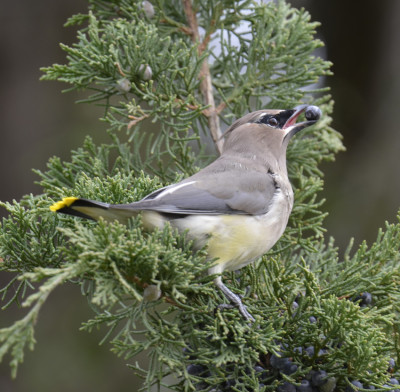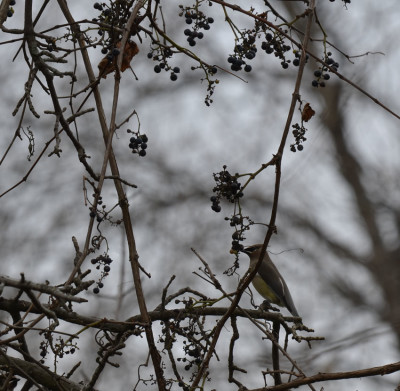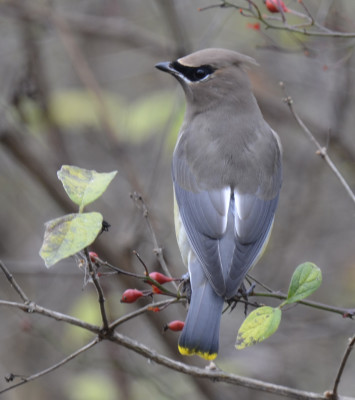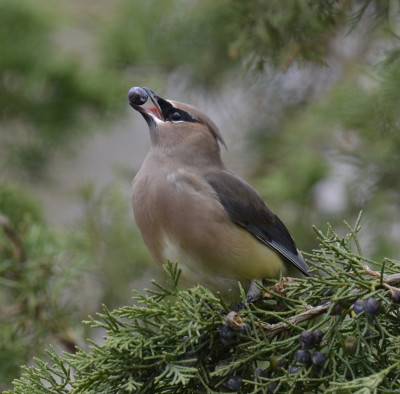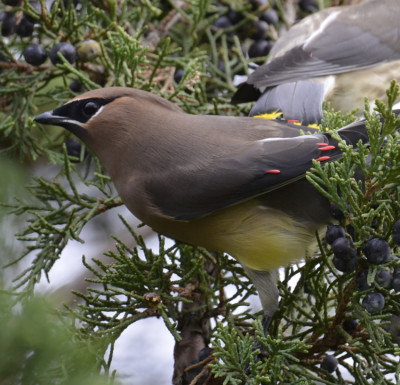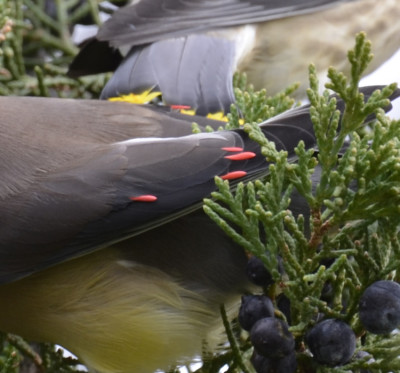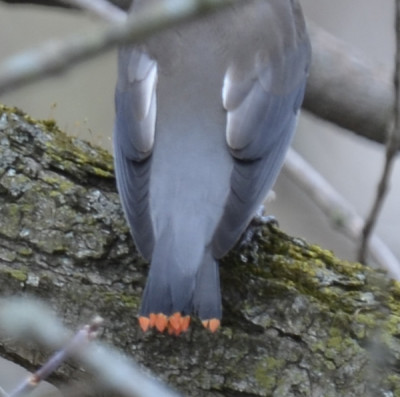We’ve been having an unusually pleasant November this year in southern Ontario. There were both frosts and even light snow in October but then the weather warmed back up and a series of storms from the south brought up record high temperatures. So I wasn’t surprised to see a huge flock of Cedar Waxwings swirling through the trees on November 18 at Arkendo Park in Oakville at the edge of Lake Ontario.
Why Hadn’t the Cedar Waxwings Flown South?
I think they were planning to. They were noticeably anxious and skittish. They spent as much time flying as feeding. There was an air of frenzy about them as they swooped in, gobbled fruit and swept away. Big breakers were pounding ashore, though, and there was little or no chance they would find it easy to try to fly south against it, or indeed to fly in any direction outside of the sheltered creek edge.
I suspect the instant the winds calmed, they were probably off.
What Were the Cedar Wings Finding to Eat in Autumn?
The weather was strangely warm and many small flying insects were hovering around the trees. I suspect some of these were being snatched up by hungry Waxwings. This summer, I saw Waxwings “hawking” for insects both over the Credit River and in the clearings in Bronte Creek Provincial Park.
However, what they were obviously eating in huge amounts was fruit.
First, the entire flock began foraging on wild Riverbank Grapes. The vines are draped high in some of the mature trees at Arkendo and the birds were happy with the high location and the abundant clusters of purple-black grapes.
Later, one of the sub-flocks descended en masse on a shrub covered in multlflora rosehips. While some perched and ate, others actually hovered to pick off a meal. I had thought they must be after insects but reading up on the birds says they will also hover to get fruit.
And, at the end of my visit, they suddenly decided that the bumper crop of Juniper berries high in a tree form Juniper was worth raiding. At times the boughs were literally bending under the weight of 3 to 5 birds only a tail tip apart.
Why Are These Cedar Waxwings So Brown and Streaky Looking?
I’ve only included a few photos here but I have photos of birds with a huge spectrum of colouring: their chests are everything from solid tan, to streaks of brown and white, to pure yellow. That’s because it was a mixed flock. Many of the birds were in immature plumage but others had the full adult colours. The streaky birds are juveniles.
Where Is the Wax on the Waxwings Wings?
I happened to capture a fairly clear photo of the strange red feather tips on one of the Waxwings wings. You can see why whoever named them all those years ago chose the descriptive term. It does look like the end of the feather has been dipped into something red and plastic-y and sealing wax for letters did have a similar appearance.
Why Does This Cedar Waxwing Have Red or Orange Instead of Yellow Tail Tips?
I was trying to get a photo or two of each individual bird in a group of flocks of about 35 or more individuals. None of whom had the least interest in staying perched for more than a few seconds at a time. Made for a busy half-hour.
So this particular bird really caught my eye. Instead of the band of bright yellow along the tip of its tail, it had a noticeably red tail end, which on the computer at home looks more orange than it did in the dim forest light.
The Cornell University website provided an explanation. Apparently, if the bird is feeding on a specific type of fruit when it is growing its new tail feathers, the tips will be orange or red. The fruit is from an imported variety of honeysuckle. I would guess that someone watching their local Cedar Waxwings mature may have been the one who connected the fruit and the colouring.
I think this one may have been my favourite Waxwing of the day because it showed me and taught me something new. It’s a good thing I don’t change colour noticeably, though, when I eat chocolate or I’d be busted at a glance, too!
Any Bohemian Waxwings Visiting Arkendo?
From what I could tell, there was not one Bohemian Waxwing in the large flock, which doesn’t surprise me this far south this soon after summer. But I’ll keep an eye on any Waxwings I see in case one does come south later this year.
Related Reading
- It’s Raining Red-Bellied Woodpeckers and Cedar Waxwings
- Not So Deadly Nightshade Berries Provide Food for Birds
- How Robins Can Survive the Winter
Join In
Do Waxwings flock in and strip your Mountain Ash or Crabapple of all of its fruit? Please share your sighting with a comment.

